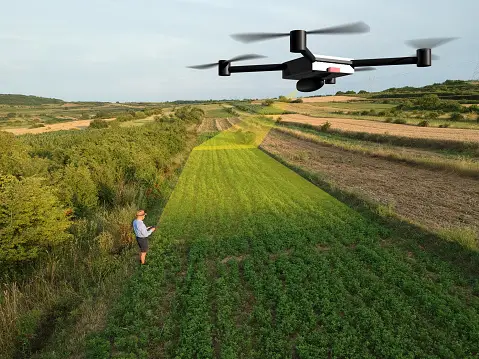"Augmented Reality for Drone Piloting: Enhancing Training and Applications"
- Aishwarya
- Jun 27, 2023
- 6 min read
Updated: Sep 10, 2023
Augmented Reality Applications for Drone Piloting and Training: Revolutionizing the Way We Fly.
Discover the cutting-edge world of augmented reality applications for drone piloting and training. Explore the benefits, advancements, and future potential of integrating augmented reality technology into drone operations. This interactive blog provides valuable insights for professionals with in-depth knowledge of the drone industry.
Welcome to a fascinating journey into the realm of augmented reality (AR) applications for drone piloting and training. As professionals with a deep understanding of the drone industry, you are well aware of the potential and complexities involved in unmanned aerial systems. In this interactive blog, we will delve into the transformative impact of augmented reality technology, exploring its benefits, advancements, and future possibilities. By the end of this exploration, you will gain valuable insights into the world of augmented reality and its applications in drone piloting and training.
I. Understanding Augmented Reality for Drone Piloting and Its Technology Relevance :
1.1. Decoding Augmented Reality: Differentiating from VR and MR
Augmented reality (AR) is a technology that overlays digital information, such as images, text, or 3D models, onto the real-world environment. It enhances the user's perception and interaction with the physical world by seamlessly blending virtual elements into the real world. Unlike virtual reality (VR), which creates a fully immersive digital environment, AR supplements the real-world experience with virtual content. It is important to differentiate AR from mixed reality (MR), which refers to the spectrum between fully virtual and fully real environments, allowing virtual and real objects to coexist and interact.
When it comes to drones, augmented reality opens up a world of possibilities. The convergence of AR and drone technology offers unique advantages and potential synergies:
-Enhanced Situational Awareness: Augmented reality provides drone pilots with real-time, contextual information overlaid onto their field of view. This includes crucial flight data, telemetry, and environmental conditions, such as wind speed and temperature. By having this information readily available, pilots can make more informed decisions, improve situational awareness, and fly their drones with greater precision and confidence.
-Virtual Obstacle Detection and Collision Avoidance: AR can assist drone pilots in identifying potential obstacles or hazards in real time. By using computer vision and object recognition algorithms, augmented reality systems can detect and highlight objects that might pose a risk to the drone's flight path. This feature is particularly valuable when navigating complex or crowded environments, enabling pilots to avoid collisions and ensure the safety of their drones.
-Waypoint Navigation and Path Planning: Augmented reality can simplify the process of setting waypoints and planning flight paths for drones. By superimposing waypoints onto the real-world view, pilots can visualize and fine-tune the trajectory of their drones, optimizing routes and ensuring accurate positioning. This interactive and intuitive approach to navigation streamlines the planning process, making it more efficient and user-friendly.
1.2. The synergy between AR and drones for piloting and training:
The integration of augmented reality and drones represents a powerful combination. AR empowers drone pilots with valuable information, improves safety, and enhances operational efficiency. As the technology continues to advance, we can expect even more innovative applications and exciting synergies between augmented reality and drone technology. The future holds tremendous potential for transforming the way we pilot and interact with drones, opening up new opportunities across various industries.
2. Augmented Reality in Drone Training:
2.1. Revolutionizing Drone Training: Immersive AR Flight Simulations
-Immersive Flight Simulation: Augmented reality brings a paradigm shift to drone training by offering realistic and immersive flight simulations. With AR-enabled training systems, aspiring drone pilots can experience virtual environments that closely resemble real-world scenarios. These simulations provide a safe and controlled environment for trainees to practice various flight maneuvers, emergency procedures, and challenging scenarios. By overlaying virtual obstacles, terrain features, and realistic weather conditions, augmented reality enhances the training experience and prepares pilots for real-life situations with increased confidence and competence.
-Training for complex operations: Exploring how AR can assist in training for specialized operations such as search and rescue, inspection, and precision agriculture, by overlaying critical information and procedural guidance for trainees.
Training for Complex Operations: Augmented reality plays a crucial role in training for specialized drone operations, such as search and rescue, inspection, and precision agriculture. By integrating AR technology, trainees can benefit from overlaid critical information and procedural guidance directly onto their field of view. For instance, during a search and rescue training session, augmented reality can overlay waypoints, vital rescue data, and even thermal imaging overlays to help trainees locate and rescue simulated victims effectively. In precision agriculture training, AR can provide real-time data on crop health, highlighting areas that require attention or treatment. These applications of augmented reality enhance trainees' abilities to perform complex operations with precision and efficiency.
-Remote collaboration and mentoring: Discussing the potential for augmented reality to enable remote collaboration and mentoring in drone training, facilitating knowledge sharing and skills development across geographical boundaries.
Remote Collaboration and Mentoring: Augmented reality opens up opportunities for remote collaboration and mentoring in drone training, breaking geographical boundaries. Trainees can receive real-time guidance and feedback from experienced instructors or mentors, regardless of their physical location. Through AR-enabled devices, such as smart glasses or tablets, mentors can superimpose instructions, annotations, or diagrams onto the trainee's field of view, enhancing the learning experience. This capability allows for knowledge sharing, skills development, and expert guidance, making drone training more accessible and scalable.
Augmented reality transforms drone training by providing immersive flight simulations, facilitating training for specialized operations, and enabling remote collaboration. It equips trainees with practical skills, enhances decision-making abilities, and prepares them for real-world challenges. As augmented reality technology advances, we can anticipate even more sophisticated training applications, ensuring safer and more proficient drone operations in diverse industries.
3. Advancements and Future Potential of AR in drone piloting and Training:
3.1 Advancements in AR-Enabled Drone Platforms: Exploring HUDs, Gesture Controls, and Wearable Integration.
-AR-Enabled Drone Platforms: The evolution of augmented reality has led to the development of AR-enabled drone platforms. These platforms incorporate features like heads-up displays (HUDs), which project critical flight information directly onto the pilot's field of view, eliminating the need to glance at a separate screen. HUDs enhance situational awareness, allowing pilots to access vital data without losing sight of their drones. Additionally, gesture-based controls enable intuitive interaction with the drone, reducing the reliance on traditional controllers. Integration with wearable devices, such as smart glasses or augmented reality headsets, provides a seamless and immersive experience for pilots, enhancing their capabilities and paving the way for more intuitive drone piloting interfaces.
3.2. "Enhancing Drone Piloting with AI and Computer Vision in Augmented Reality".
-Artificial Intelligence and Computer Vision Integration: The integration of artificial intelligence (AI) and computer vision technologies with augmented reality holds immense potential for drone piloting and training. AI algorithms can analyze real-time data from drone sensors and cameras to provide intelligent insights and decision support to the pilot. Computer vision algorithms can identify objects, people, or terrain features and overlay augmented reality annotations or warnings to aid in navigation or situational awareness. This fusion of AI, computer vision, and augmented reality enhances the capabilities of drone systems, making them more intelligent, adaptable, and efficient.
3.3. "Transforming Drone Operations: Industry Use Cases and Emerging AR Trends"
-Industry Use Cases and Emerging Trends: Augmented reality is already transforming drone operations across various industries. In construction and architecture, AR can overlay virtual models onto physical structures, facilitating design visualization and on-site project management. In cinematography, filmmakers can use AR to pre-visualize shots and camera movements, saving time and resources during production. In the field of inspection and maintenance, augmented reality overlays maintenance instructions, checklists, and annotations onto real-world assets, enabling technicians to perform tasks with precision and efficiency. These are just a few examples of how augmented reality is revolutionizing drone operations, and the potential applications are constantly expanding.
Looking to the future, we can expect several emerging trends in the intersection of augmented reality and drones. Improved accuracy and reliability of computer vision algorithms will enable more advanced object detection, tracking, and recognition, enhancing AR applications. The integration of augmented reality with other emerging technologies, such as 5G connectivity, edge computing, and the Internet of Things (IoT), will further augment the capabilities of drone systems. As AR-enabled drone platforms become more accessible and user-friendly, we can anticipate an increased adoption of augmented reality in drone piloting and training, leading to safer, more efficient, and innovative drone operations.
The advancements in AR-enabled drone platforms, the integration of AI and computer vision technologies, and the transformative use cases across industries demonstrate the immense potential of augmented reality in the drone industry. As technology continues to evolve, augmented reality will continue to push the boundaries of drone piloting, training, and operational efficiency, shaping a future where drones are seamlessly integrated into our daily lives.
Conclusion:
As a professional with in-depth knowledge of the drone field, you are at the forefront of innovation and technological advancements. Augmented reality presents a game-changing opportunity to enhance drone piloting and training, unlocking new levels of efficiency, safety, and immersive experiences. By leveraging AR applications, we can revolutionize the way we fly drones, ensuring optimal situational awareness, precise navigation, and realistic training scenarios.



























Comments